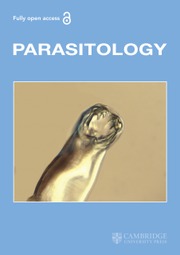Crossref Citations
This article has been cited by the following publications. This list is generated based on data provided by
Crossref.
Troell, Karin
Engström, Annie
Morrison, David A.
Mattsson, Jens G.
and
Höglund, Johan
2006.
Global patterns reveal strong population structure in Haemonchus contortus, a nematode parasite of domesticated ruminants.
International Journal for Parasitology,
Vol. 36,
Issue. 12,
p.
1305.
Kopp, S. R.
Kotze, A. C.
McCarthy, J. S.
Morton, J. M.
and
Coleman, G. T.
2008.
Strategies for the Storage of Ancylostoma caninum Third-Stage Larvae.
Journal of Parasitology,
Vol. 94,
Issue. 3,
p.
755.
van DIJK, J.
and
MORGAN, E. R.
2008.
The influence of temperature on the development, hatching and survival ofNematodirus battuslarvae.
Parasitology,
Vol. 135,
Issue. 2,
p.
269.
Kopp, S. R.
Kotze, A. C.
McCarthy, J. S.
Morton, J. M.
and
Coleman, G. T.
2008.
Strategies for the Storage of Ancylostoma caninum Third-Stage Larvae.
Journal of Parasitology,
Vol. 94,
Issue. 3,
p.
755.
van Dijk, J.
and
Morgan, E.R.
2010.
Variation in the hatching behaviour of Nematodirus battus: Polymorphic bet hedging?.
International Journal for Parasitology,
Vol. 40,
Issue. 6,
p.
675.
Angulo-Cubillán, F.J.
García-Coiradas, L.
Alunda, J.M.
Cuquerella, M.
and
de la Fuente, C.
2010.
Biological characterization and pathogenicity of three Haemonchus contortus isolates in primary infections in lambs.
Veterinary Parasitology,
Vol. 171,
Issue. 1-2,
p.
99.
Morgan, E.R.
and
van Dijk, J.
2012.
Climate and the epidemiology of gastrointestinal nematode infections of sheep in Europe.
Veterinary Parasitology,
Vol. 189,
Issue. 1,
p.
8.
Skuce, P.J.
Morgan, E.R.
van Dijk, J.
and
Mitchell, M.
2013.
Animal health aspects of adaptation to climate change: beating the heat and parasites in a warming Europe.
Animal,
Vol. 7,
Issue. ,
p.
333.
Rose, Hannah
Hoar, Bryanne
Kutz, Susan J.
and
Morgan, Eric R.
2014.
Exploiting parallels between livestock and wildlife: Predicting the impact of climate change on gastrointestinal nematodes in ruminants.
International Journal for Parasitology: Parasites and Wildlife,
Vol. 3,
Issue. 2,
p.
209.
Rose, Hannah
Wang, Tong
van Dijk, Jan
and
Morgan, Eric R.
2015.
GLOWORM-FL: A simulation model of the effects of climate and climate change on the free-living stages of gastro-intestinal nematode parasites of ruminants.
Ecological Modelling,
Vol. 297,
Issue. ,
p.
232.
Silva, M.R.L.
Amarante, M.R.V.
Bresciani, K.D.S.
and
Amarante, A.F.T.
2015.
Host-specificity and morphometrics of female Haemonchus contortus, H. placei and H. similis (Nematoda: Trichostrongylidae) in cattle and sheep from shared pastures in São Paulo State, Brazil.
Journal of Helminthology,
Vol. 89,
Issue. 3,
p.
302.
Besier, R.B.
Kahn, L.P.
Sargison, N.D.
and
Van Wyk, J.A.
2016.
Haemonchus contortus and Haemonchosis – Past, Present and Future Trends.
Vol. 93,
Issue. ,
p.
95.
Rose Vineer, H.
Steiner, J.
Knapp-Lawitzke, F.
Bull, K.
von Son-de Fernex, E.
Bosco, A.
Hertzberg, H.
Demeler, J.
Rinaldi, L.
Morrison, A.A.
Skuce, P.
Bartley, D.J.
and
Morgan, E.R.
2016.
Implications of between-isolate variation for climate change impact modelling of Haemonchus contortus populations.
Veterinary Parasitology,
Vol. 229,
Issue. ,
p.
144.
Gilleard, J.S.
and
Redman, E.
2016.
Haemonchus contortus and Haemonchosis – Past, Present and Future Trends.
Vol. 93,
Issue. ,
p.
31.
Ma, Guangxu
Wang, Tao
Korhonen, Pasi K.
Stroehlein, Andreas J.
Young, Neil D.
and
Gasser, Robin B.
2019.
Dauer signalling pathway model for Haemonchus contortus.
Parasites & Vectors,
Vol. 12,
Issue. 1,
Rose Vineer, H.
Baber, P.
White, T.
and
Morgan, E.R.
2019.
Reduced egg shedding in nematode-resistant ewes and projected epidemiological benefits under climate change.
International Journal for Parasitology,
Vol. 49,
Issue. 12,
p.
901.
Mancilla-Montelongo, Gabriela
Castañeda-Ramírez, Gloria Sarahi
Can-Celis, Alhely
Chan-Pérez, José Israel
Sandoval-Castro, Carlos Alfredo
and
Torres-Acosta, Juan Felipe de Jesús
2020.
Optimal age of Trichostrongylus colubriformis larvae (L3) for the in vitro larval exsheathment inhibition test under tropical conditions.
Veterinary Parasitology,
Vol. 278,
Issue. ,
p.
109027.
Sauermann, Christian W.
Candy, Paul
Waghorn, Tania S.
Bekelaar, Kiliana
and
Leathwick, Dave M.
2021.
Host effects on the free-living stages of Haemonchus contortus.
Veterinary Parasitology,
Vol. 292,
Issue. ,
p.
109401.
Bartley, David J.
Andrews, Leigh
Melville, Lynsey A.
McBean, David
Skuce, Philip
and
Morrison, Alison A.
2021.
Integrating applied parasitological and molecular epidemiological methodologies to investigate the capacity of Haemonchus contortus to over‐winter on pasture in Scotland.
Veterinary Record,
Vol. 189,
Issue. 3,
Chylinski, Caroline
Cortet, Jacques
Cabaret, Jacques
and
Blanchard, Alexandra
2023.
Haemonchus contortus Adopt Isolate-Specific Life History Strategies to Optimize Fitness and Overcome Obstacles in Their Environment: Experimental Evidence.
Animals,
Vol. 13,
Issue. 11,
p.
1759.




